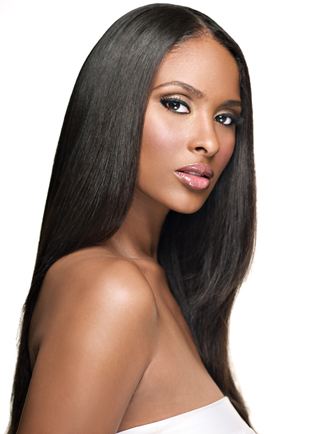How a cosmetology student launched a multibillion-dollar industry

When Indique Hair cofounder Ericka was a child, her dolls served one role: hair models.
"I always tell people my Barbies didn't have a chance!" the now 43-year-old laughed. As a young girl, she'd open the pink boxes and immediately get to work improving each doll's factory-made hairstyle.
Thirty years later, her drive for aesthetic perfection launched a multibillion dollar industry. If you've seen pictures of Rihanna, Jennifer Hudson, Lady Gaga, or Jennifer Lawrence recently, you've seen the results of Dotson's career switch. Indique Hair was the first company to brand imported natural hair pieces, and is now the the country's largest premium hair retailer and the favorite of celebrities.
Dotson's especially proud of her rise as an African-American woman at the head of a business where the primary consumer is African-American women. She often advises young African-American entrepreneurs.
"It's just amazed me," she said over the phone from the office behind her Atlanta, Georgia boutique -- one of the web-based company's 13 brick-and-mortar locations, "just what's happened over this short course of time. It's really changed the game. And I'm just so happy to be a part of it."
But in the early 2000's, Dotson couldn't have been farther from the top of the beauty industry. After a string of finance jobs in New York, she was working for a cellular company in her hometown of Austin, Texas.
"I felt like I was dying inside," she remembered. "I was like, I need the job, I have a young daughter I'm supporting on my own. But I felt like something else was calling me."
Dotson missed working with hair -- she'd done all of her friends' styles in college -- so she decided to enroll in cosmetology school.
"Everyone thought I was crazy," she said. "They were like, 'Oh my gosh, you have such a cush job.' I said 'Yeah, but it's not doing anything for me. I'm miserable.'"
She held onto her day job and spent the next few years going to school part time. But she soon developed a crippling handicap -- an allergy to hair dye. Many stylists make the majority of their income from coloring appointments. Fortunately, she found herself unexpectedly satisfied by another styling process, hair extensions.
"It's like creating art on someone's head," she said. "And the results are so jaw-dropping, some of my clients were almost in tears sometimes at times. You can change someone's entire look style and demeanor with in a couple of hours with hair extensions."
Dotson started pairing with photographers and makeup artists to create a portfolio of her work, which put her in demand for editorial photo shoots and New York Fashion Week. Through these jobs she discovered what stylists call "premium" hair -- real human hair, typically imported from India, that has never been chemically treated and has its cuticle intact. She was hooked.

"It was hard to get though," she said. "I couldn't go to my local beauty supply store in Austin and purchase it." She could only find one reliable source, out in California.
She'd meet with her client for a consultation, order the hair, and if it was available, she'd then make another appointment with the client to install the hair.
"It was was very tiresome," she remembered. "I was the educator, I was the one that purchased it, I was the one running to FedEx, I was the one booking two appointments for one client."
Dotson thought there had to be a better solution to connect clients with the Indian hair. She started searching for a way to get a cache of hair on hand to show her customers, so she could avoid using a middleman to get every client's hairpiece. But when she tried ordering hair herself it came full of nits.
"I was just like, 'Oh my gosh, this is not for me!'" she remembered thinking to herself. '''Maybe I'm just barking up the wrong tree, I probably just need to stay in my own lane and purchase from someone who this is their business.'"
In August 2007, on the exact day she decided to give up finding her own connection to imported hair, she received a call from Krishan Jhalani, her current business partner. Word had spread that this Austin stylist was looking to order Indian hair. Jhalani was living in Washington D.C. and was already importing Indian hair himself. He offered Dotson some generous samples.
"I'm also a techie nerd," Dotson said. "I create websites, I'm all into design and everything too. And I noticed that Krishan's website wasn't so great. There weren't any images, and I'm thinking, he needs images."
She proposed an exchange. If he provided the hair, she'd arrange a photo shoot with models and a makeup artist, and they could share the resulting images for their respective websites.
"I guess through those discussions," Dotson said, "he was like, 'This is the girl!'"
Jhalani proposed the two start a business branding, importing, and retailing premium Indian hair. They launched Indique Hair within a month.
"When we first started the brand," Dotson remembered, "it was like the wild wild West. It was literally no information available on the internet, [other sites'] images weren't the actual images of the hair, it was probably like a copy and paste of Beyonce."
"Fifteen years ago," Mintel multicultural analyst Tonya Roberts said, "weaves, wigs, and hair extensions weren't as common and weren't as acceptable." That's changed, she said. Her recent survey of over 1,200 African-American women showed 52% had a weave within the past twelve months.
Dotson said when Indique Hair first started, people didn't really understand what imported Indian hair was.
"I had to teach people," she said, "[that] the packaged hair you get from the beauty supply store is synthetic and has a silicon coating on it. Our natural hair, it's untouched, cuticles are intact flowing from the root to the end in the natural direction. And it comes from an actual human being, like a donor from the temples of India."
For some Indian women, tradition dictates that they regularly cut off their hair as a sign of humility, and donate the hair to their temple. The temple then receives the proceeds from hair sales.
For a lot of people this can induce a cringe, at the least. "The hair business," writes journalist and anthropologist Scott Carney, "is a perfect totem to highlight globalization's odd alchemy. A product created out of an act of absolute humility is transformed by global businesses into a a high-profit beauty enhancer that feeds the West's lust for vanity."
Indique hair sells in four-ounce tubes, containing long strips of hair-like curtains. The hair comes attached to a seam at the root, and that seem can be braided or clipped into a client's hair. Tubes typically sell for over $100, and women typically need more than one. Dotson says the hairpieces should last at least a year.
"Based on market research," Tonya Roberts at Mintel said, "Black consumers may be willing to make sacrifices in other areas to afford that weave. In the long run if they're using a good quality weave they may not have to get done as frequently and it looks more natural."
Dotson and Khalani marketed Indique Hair solely to stylists for the first year. They then started selling it to consumers online. But it was after they started opening their boutiques in 2010 that sales really took off. Sales have grown every year since, despite a recent trend in more natural hair styles. Last year alone Indique Hair sales topped $10 million.
"There's no book out there on how to run a hair business," Dotson said. "Because we're the pioneers in this industry, it's been a rough road. It hasn't been easy at all."
The business has spurred a number of copycats. Dotson estimates the entire hair piece industry is now at about $18 billion, including synthetic products. But Indique Hair remains the only premium hair retailer with multiple brick and mortar locations.
She credits her success to her aesthetic intuition. She put the majority of Indique's early marketing funds into photo shoots.
"It's all about the imagery. That's going to draw people to your brand. Everything's on the internet now, and since we didn't have actual stores, that was our bread and butter."
"I believe that a specific face can really capture an audience. So I'm particular about the type of models that I choose for our campaigns. And that helps us a lot."
Dotson also says it's helped her to be fearless.
"Maybe because we have been on the forefront of the industry, and we just have to try it, I've never told myself, 'No, you'd better not do that.' I'm just like, let's try it. That's all we can do. And if there's something that I strongly believe, I'm going to back it 100%."
One last goal for Dotson? The ultimate celebrity endorsement for Indique Hair: Beyonce.
"I have Rihanna!" she laughed, "but not Beyonce."
Brain Waves
What is the best advice you ever received? It may sound cliché, but my father always told me told me don't let anyone persuade you it can't be done. For example, when I decided to get out of the tech industry and go into cosmetology school I told my instructor I really wanted to focus on hair weaves and extensions. And I was just going to dive in and open up my own little studio. And she told me, "You can't do that."
What was your biggest mistake? I did something for quick money. I was still in cosmetology school and started a cleaning business. I was able to find people to work for me and clean, and I landed a couple of accounts at corporate offices using my business savvy. But I found out that my main cleaning person, she wouldn't show up. I was on pins and needles, and I ended up having to do the cleaning. Never again will I put myself in a position where I have to do something I'm not passionate about.
What would you tell your younger self? I do remember times when I was trying to be with "in" groups. It was all about putting yourself into a box. What I should have told myself is, "Create your own box Ericka, don't try to fit into someone else's." It's all about staying ahead of the curve, having something that's fresh and new.
Sign up for our newsletter featuring in-depth business innovation stories by correspondents around the globe, top domestic reporters and thought-provoking opinion columnists.
This post was originally published on Smartplanet.com